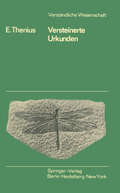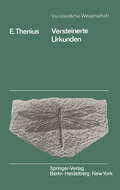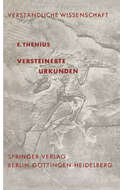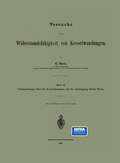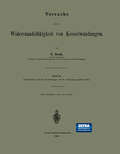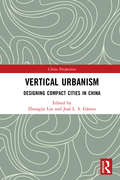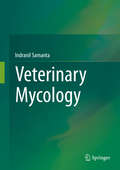- Table View
- List View
Versickerungsfähige Verkehrsflächen: Anforderungen, Einsatz und Bemessung
by S. Borgwardt A. Gerlach M. KöhlerKanalnetzüberlastungen, Grundwasserabsenkungen und Hochwasserspitzen sind nur einige negative Auswirkungen der Versiegelung auf den natürlichen Wasserhaushalt. Gerade die neueren Entwicklungen hinsichtlich der Neufassung von Bodenschutzgesetzgebung, Landeswassergesetzen und kommunalen Abwassersatzungen zur Förderung des schonenden Umgangs mit Boden und Wasser lassen die Bedeutung von ökologischen Bauweisen immer wichtiger erscheinen. Der Einsatz versickerungsfähiger Verkehrsflächenbefestigungen ist hierbei ein zunehmend unentbehrlicher Baustein, um Regenwasser wieder naturnah zu bewirtschaften und damit die weitreichenden Folgen der Versiegelung zu verringern. Beim Einsatz versickerungsfähiger Befestigungssysteme sollen aufgrund ihrer Konstruktion Niederschläge direkt auf der Fläche aufgenommen und somit durch verringerte Oberflächenabflüsse die Kanalisation entlastet und die Versiegelung vermindert werden.
Versteinerte Urkunden: Die Paläontologie als Wissenschaft vom Leben in der Vorzeit (Verständliche Wissenschaft #81)
by E. TheniusVersteinerte Urkunden: Die Paläontologie als Wissenschaft vom Leben in der Vorzeit (Verständliche Wissenschaft #81)
by E. TheniusVersteinerte Urkunden: Die Paläontologie als Wissenschaft vom Leben in der Vorzeit (Verständliche Wissenschaft #81)
by E. TheniusGerne ist der Unterzeichnete der Aufforderung des Heraus gebers gefolgt, im Rahmen der Reihe "Verständliche Wissenschaft" einen Band über die Paläontologie zu verfassen. Der von Prof. Dr. E. Dacque im Jahre 1928 veröffentlichte Band "Das fossile Lebewesen - Eine Einführung in die Versteinerungskunde" ist längst vergriffen. Außerdem erschien in Anbetracht der Fort schritte der Paläontologie und der Nachbarwissenschaften im Laufe der letzten Jahrzehnte, die nicht nur zu neuen Erkenntnissen geführt, sondern auch entscheidend zur Lösung einst offener Probleme beigetragen haben, eine neue, allgemein verständliche Darstellung dieses Wissensgebietes notwendig. Damit sind auch Sinn und Zweck dieses Bandes klar umrissen. Es ist keine systematisch oder chronologisch geordnete Übersicht über die paläontologischen Urkunden, sondern der Versuch, auch weiteren Leserkreisen eine Vorstellung von der Bedeutung, den verschiedenen Methoden und den Zielen, aber auch von den Grenzen paläontologischer Forschung zu vermitteln. Wenn dies gelungen und damit auch dem Nichtfachmann gezeigt ist, daß die Paläontologie gegenwärtig alles andere als eine reine Museums wissenschaft darstellt, so ist der Zweck dieser Zeilen erreicht. Denn die Paläontologie besitzt, wie im Folgenden gezeigt werden soll, nicht nur große Bedeutung für die Geologie in der Praxis (durch die Mikropaläontologie und Palynologie), sondern ist vor allem auch für die Biologie bei der Beurteilung stammesgeschicht licher Fragen von grundsätzlicher Wichtigkeit.
Versuche über die Widerstandsfähigkeit von Kesselwandungen: Heft 3. Untersuchungen über die Formänderungen und die Anstrengung flacher Böden
by C. BACHVersuche über die Widerstandsfähigkeit von Kesselwandungen: Heft 5. Untersuchungen über die Formänderungen und die Anstrengung gewölbter Böden
by C. BACHVertebrate Palaeontology
by Michael J. BentonVertebrate Palaeontology is a complete, up-to-date history of the evolution of vertebrates. The third edition of this popular text has been extensively revised to incorporate the latest research, including new material from North and South America, Australia, Europe, China, Africa and Russia. Highlights astonishing new discoveries including new dinosaurs and Mesozoic birds from China features a new chapter on how to study fossil vertebrates provides an increased emphasis on the cladistic framework with cladograms set apart from the body of the text and full lists of diagnostic characters includes new molecular evidence on early mammal diversification new features aid study including new functional and developmental feature spreads, key questions and extensive references to useful web sites strong phylogenetic focus making it an up-to-date source of the latest broad-scale systematic data on vertebrate evolution To access the artwork from the book, please visit: www.blackwellpublishing.com/benton. An Instructor manual CD-ROM for this title is available. Please contact our Higher Education team at HigherEducation@wiley.com for more information.
Verteilung und jährlicher Gang der Niederschläge in den Alpen (Veröffentlichungen des Königlich Preußischen Meterologischen Instituts)
by Karl Knoch Eberhard ReichelDieser Buchtitel ist Teil des Digitalisierungsprojekts Springer Book Archives mit Publikationen, die seit den Anfängen des Verlags von 1842 erschienen sind. Der Verlag stellt mit diesem Archiv Quellen für die historische wie auch die disziplingeschichtliche Forschung zur Verfügung, die jeweils im historischen Kontext betrachtet werden müssen. Dieser Titel erschien in der Zeit vor 1945 und wird daher in seiner zeittypischen politisch-ideologischen Ausrichtung vom Verlag nicht beworben.
Vertex Operators in Mathematics and Physics: Proceedings of a Conference November 10–17, 1983 (Mathematical Sciences Research Institute Publications #3)
by J. Lepowsky S. Mandelstam I. M. SingerJames Lepowsky t The search for symmetry in nature has for a long time provided representation theory with perhaps its chief motivation. According to the standard approach of Lie theory, one looks for infinitesimal symmetry -- Lie algebras of operators or concrete realizations of abstract Lie algebras. A central theme in this volume is the construction of affine Lie algebras using formal differential operators called vertex operators, which originally appeared in the dual-string theory. Since the precise description of vertex operators, in both mathematical and physical settings, requires a fair amount of notation, we do not attempt it in this introduction. Instead we refer the reader to the papers of Mandelstam, Goddard-Olive, Lepowsky-Wilson and Frenkel-Lepowsky-Meurman. We have tried to maintain consistency of terminology and to some extent notation in the articles herein. To help the reader we shall review some of the terminology. We also thought it might be useful to supplement an earlier fairly detailed exposition of ours [37] with a brief historical account of vertex operators in mathematics and their connection with affine algebras. Since we were involved in the development of the subject, the reader should be advised that what follows reflects our own understanding. For another view, see [29].1 t Partially supported by the National Science Foundation through the Mathematical Sciences Research Institute and NSF Grant MCS 83-01664. 1 We would like to thank Igor Frenkel for his valuable comments on the first draft of this introduction.
Vertical and Decline Shaft Sinking: Good Practices in Technique and Technology, International Mining Forum 2015
by Jerzy Kicki Eugeniusz J. Sobczyk Pawel KaminskiShaft sinking for underground transportation purposes is a very complex technological process in mining and geotechnology which requires specific and specially designed technological equipment. This technological process is dealt with for a long time, since mining is one of the oldest industries in the world.This book presents the te
Vertical and Lateral Erosion (tactile)
by RnibThis is a tactile diagram for GCSE level students. It shows vertical and lateral erosion. Labels and textures help the reader to navigate the image.
The Vertical Farm: Scientific Advances and Technological Developments (Nextgen Agriculture)
by Kheir Al-Kodmany Andrew Keong Ng Abel Tablada Chittaranjan KoleAmid economic uncertainties, fluctuating oil prices, and a rising environmental consciousness, the need for sustainable and efficient food production has become dire. The Vertical Farm: Scientific Advances and Technological Developments systematically navigates the realm of vertical farming (VF), rooted in a robust, scientific foundation. Unveiling the intricate convergence of plant biology, environmental science, and agronomy, it provides a profound understanding of contemporary agriculture. The book spans lighting systems and climate control mechanisms, focusing on sustainability. From small urban initiatives to significant commercial endeavors, real-world case studies showcase VF's adaptability, scalability, and resilience. Addressing multiple challenges, the book explores economic considerations and public perceptions, recognizing their roles in fostering meaningful advancements in agricultural innovation.A volume in the Nextgen Agriculture series, this book is valuable to scientists, practitioners, and students in urban agriculture and planning, horticulture, engineering, landscape architecture, and plant/technology sciences.
The Vertical Farm: Scientific Advances and Technological Developments (Nextgen Agriculture)
Amid economic uncertainties, fluctuating oil prices, and a rising environmental consciousness, the need for sustainable and efficient food production has become dire. The Vertical Farm: Scientific Advances and Technological Developments systematically navigates the realm of vertical farming (VF), rooted in a robust, scientific foundation. Unveiling the intricate convergence of plant biology, environmental science, and agronomy, it provides a profound understanding of contemporary agriculture. The book spans lighting systems and climate control mechanisms, focusing on sustainability. From small urban initiatives to significant commercial endeavors, real-world case studies showcase VF's adaptability, scalability, and resilience. Addressing multiple challenges, the book explores economic considerations and public perceptions, recognizing their roles in fostering meaningful advancements in agricultural innovation.A volume in the Nextgen Agriculture series, this book is valuable to scientists, practitioners, and students in urban agriculture and planning, horticulture, engineering, landscape architecture, and plant/technology sciences.
Vertical Reference Systems: IAG Symposium Cartagena, Colombia, February 20–23, 2001 (International Association of Geodesy Symposia #124)
by Alan H. Dodson Luiz P. S. Fortes Laura Sanchez Pedro Sandoval Hermann DrewesThe Symposium on Vertical Reference Systems (VeReS) was initiated on the occasion of the XXII General Assembly of the International Union of Geodesy and Geophysics (IUGG), Birmingham 1999, by Professor Dr. Wolfgang Torge, Past President of the International Association of Geodesy (lAG) and representative of lAG to the Pan-American Institute of Geography and History (PAIGH). The idea was to organise another joint symposium of lAG and PAIGH like the previous one held during the XX IUGG General Assembly at Vienna, Austria, in 1991. Good reasons for such a joint symposium were the great success and the ongoing activities of the Project on the South American Geocentric Reference System (Sistema de Referencia Geocentrico para America del Sur, SIRGAS) being sponsored by lAG and PAIGH since 1993. The SIR GAS Project (Working Group I) had presented a continental South American reference frame of 58 stations during the lAG Scientific Assembly at Rio de Janeiro, in 1997. This reference frame was already adopted by several South American countries as the basis for their new national horizontal geodetic datums (SIRGAS Working Group II). To overcome the problems of the heterogeneous vertical (height) datums between the individual countries, SIRGAS had installed its Working Group III "Vertical Datum" in 1997. As the discussion on the unification of vertical reference systems is also going on in lAG and other bodies of science and practice, it was decided to dedicate the symposium to this topic.
Vertical Seismic Profiling and Its Exploration Potential (Modern Approaches in Geophysics #1)
by E.I. GalperinThe present book is the author's third on the subject of vertical seismic profiling (VSP). Ten years have elapsed since the pUblication of the fIrst book. During this period, VSP has become the principal method of seismic observations in boreholes and the chief method of experimental studies of seismic waves in the real earth. VSP combines borehole studies in the seismic frequency band, well velocity surveys, proximity or aplanatic surveys, all of which previously existed as separate methods. The high effectiveness ofVSP, its great practical value, the express nature and clarity of the results obtained have all contributed towards a very rapid acceptance of the method. In the USSR VSP has been used in an overwhelming majority of areas and is being used increasingly in many foreign countries as well. This has been greatly facilitated by the translation into English and the publication in the U. S. A. by the Society of Exploration Geophysicists of the book Vertical Seismic Profiling (Tulsa, Oklahoma, 1974). As the method has become more familiar, it has attracted growing interest outside the USSR This has been substantiated by the special seminar on VSP (Oklahoma, 1979) which was organized for 22 U. S. companies and universities and presented by the author.
Vertical Urbanism: Designing Compact Cities in China (China Perspectives)
by Zhongjie Lin José L. S. GámezStudies of compact cities have evolved along with the rising awareness of climate change and sustainable development. Relevant debates, however, reveal that the prevailing definitions and practices of compact cities are tied primarily to traditional Western urban forms. This book reinterprets "compact city", and develops a ground-breaking discourse of "Vertical Urbanism", a concept that has never been critically articulated. It emphasizes "Vertical Urbanism" as a dynamic design strategy instead of a static form, distinguishing it from the stereotyped concept of "vertical city" or "towers in the park" dominant in China and elsewhere, and suggests its adaptability to different geographic and cultural contexts. Using Chinese cities as laboratories of investigation, this book explores the design, ecological, and sociocultural dimensions of building compact cities, and addresses important global urban issues through localized design solutions, such as the relationship between density and vitality, the integration of horizontal and vertical dimensions of design, and the ecological and social adaptability of combinatory mega-forms. In addition, through discussions with scholars from the United States, China, and Japan, this book provides an insight into the theoretical debates surrounding "compact city" and "Vertical Urbanism" in the global context. Scholars and students in architecture and urban planning will be attracted by this book. Also, it will appeal to readers with an interest in urban development and Asian studies.
Vertical Urbanism: Designing Compact Cities in China (China Perspectives)
by Zhongjie Lin José L. S. GámezStudies of compact cities have evolved along with the rising awareness of climate change and sustainable development. Relevant debates, however, reveal that the prevailing definitions and practices of compact cities are tied primarily to traditional Western urban forms. This book reinterprets "compact city", and develops a ground-breaking discourse of "Vertical Urbanism", a concept that has never been critically articulated. It emphasizes "Vertical Urbanism" as a dynamic design strategy instead of a static form, distinguishing it from the stereotyped concept of "vertical city" or "towers in the park" dominant in China and elsewhere, and suggests its adaptability to different geographic and cultural contexts. Using Chinese cities as laboratories of investigation, this book explores the design, ecological, and sociocultural dimensions of building compact cities, and addresses important global urban issues through localized design solutions, such as the relationship between density and vitality, the integration of horizontal and vertical dimensions of design, and the ecological and social adaptability of combinatory mega-forms. In addition, through discussions with scholars from the United States, China, and Japan, this book provides an insight into the theoretical debates surrounding "compact city" and "Vertical Urbanism" in the global context. Scholars and students in architecture and urban planning will be attracted by this book. Also, it will appeal to readers with an interest in urban development and Asian studies.
Very British Weather: Over 365 Hidden Wonders from the World’s Greatest Forecasters
by The Met OfficeUPGRADE YOUR SMALL TALK GUIDED BY WORLD-LEADING WEATHER EXPERTS!From Foggy and Freezing to Scorching and Stormy, join the ultimate weather adventure through the great British seasons and uncover the extraordinary in every single day*.Are YOU the ultimate weather watcher?Do you know your drizzle from your mizzle?Ever wondered what rainbows are really made of?And could you pinpoint where lightning has struck twice?Pore over beautiful cloudscapes, learn the secrets of sunsets, discover freak weather and fogbows, and why forecasting was so important in British history, from D-Day to the Great Fire of London.Perfect for rainy days in or cloudspotting on the go, the Met Office share the best of almost 170 years of forecasting for the first time in this beautifully illustrated book. Packed with mythbusting, top trivia, stunning visuals and archive gems, shooting the breeze has never been so interesting!*Even when it is tipping it down.
Very Long Baseline Interferometry: Techniques and Applications (Nato Science Series C: #283)
by Marcello Felli Ralph E. SpencerThe quest for high resolution has preoccupied radio astronomers ever since radio waves were first detected from space fifty years ago. This venture was par ticularly stimulated by the discovery of quasars, and led to the development of interferometer techniques using baselines of transglobal dimensions. These meth ods have become known as Very Long Baseline Interferometry (VLBI). Arrays of radio telescopes situated all over the Earth (or even in space) are regularly used for researches in radio astronomy, reaching resolutions as small as a fraction of a milli arcsecond. The technique also allows the measurement of the positions of the radio telescopes to a few millimeters and so VLBI has become a major tool in geodesy and the study of the rotation of the Earth. VLBI has now passed the pioneer stage and is becoming a standard facility available to astronomers and geodesists, requiring the coordination of the operations of indpendently owned radio telescopes around the world. In Europe observatories from England, Federal Republic of Germany, France, Italy, Poland, Sweden and The Netherlands are coordinated in their VLBI activity by the European VLBI Network Consortium (EVN). The Programme Committee of the EVN allocates time to scientific projects on a routine basis three times a year. The Unites States has a similar arrangement of a network of independent radio observatories, and joint experiments using 'Global Network' are often made.
Very Slow Flows of Solids: Basics of Modeling in Geodynamics and Glaciology (Mechanics of Fluids and Transport Processes #7)
by L. A. LliboutryThis book is written primarily for Earth scientists faced with problems in thermo mechanics such as the flow and evolution of ice-sheets, convection currents in the mantle, isostatic rebound, folding of strata or collapse of cavities in salt domes. Failure, faults, seismic waves and all processes involving inertial terms will not be dealt with. In general such scientists (graduate students beginning a Ph. D. for instance) have too small a background'in continuum mechanics and in numerical computation to model conveniently these problems, which are not elementary at all. Most of them are not linear, and therefore seldom dealt with in treatises. If the study of reality were clearly cut into two successive steps: first to make a physical model, setting up a well-posed problem in thermo-mechanics, and second to solve it, the obvious solution would be to find a specialist in computational mechanics who could spend enough time on a problem which, although maybe crucial for on-going fundamental research, has little practical interest in general, and cannot be considered properly as a noteworthy progress in Mechanics. But this is not the way Science develops. There is a continuous dialectic between the building up of a model and its mathematical treatment. The model should be simple enough to be tractable, but not oversimplified. Its sensitivity to the different components it is made of should be investigated, and more thought is needed when the results contradict hard facts.
Very Wonderful, Very Rare (PDF): Saving The Most Endangered Wildlife On Earth
by Ellen Butcher Jonathan BaillieThis spectacular book introduces children to some of the most endangered species on Earth, from the pygymy sloth to Attenborough's pitcher plant. It explores what scientists are doing to save species and what we can do to help, featuring wildlife that is critically endangerd alongside species that have been brought back from the brink of extinction. Large, spectacular photos and engaging text by award winning authors Jonathan and Marilyn Baillie really capture a child's attention and show why our wonderful wildlife is worth saving. Produced in assoication with the IUCN.
Vesiculation and Crystallization of Magma: Fundamentals of the Volcanic Eruption Process (Advances in Volcanology)
by Atsushi ToramaruThis book comprehensively illustrates the elemental processes of vesiculation and crystallization recorded in volcanic products on the basis of the equilibrium and non-equilibrium theories. The book describes the derivation of equations and the basic physics behind them in detail. This textbook is fundamental in preparing for future volcanic hazards. The target readers are graduate students and researchers, but Parts I and IV are written to be understandable by undergraduate students as well, to inspire them to enter this field.
Vesuvius: A Biography
by Alwyn ScarthThe volcano that has fascinated scientists, writers, and poets for two millenniaCapricious, vibrant, and volatile, Vesuvius has been and remains one of the world's most dangerous volcanoes. In its rage, it has destroyed whole cities and buried thousands alive. In its calm, its ashes have fertilized the soil, providing for the people who have lived in its shadows. For over two millennia, the dynamic presence of this volcano has fascinated scientists, artists, writers, and thinkers, and inspired religious fervor, Roman architecture, and Western literature. In Vesuvius, Alwyn Scarth draws from the latest research, classical and eyewitness accounts, and a diverse range of other sources to tell the riveting story of this spectacular natural phenomenon.Scarth follows Vesuvius across time, examining the volcano's destruction of Pompeii and Herculaneum in 79 A.D., its eruptions during the Counter-Reformation that were viewed as God's punishment of sinners, and the building of the world's first volcano observatory on Vesuvius in the 1840s. Scarth explores the volcano's current position overlooking a population of more than three million people and the complex attitudes maintained by the residents, at once reverent, protective, and fearful. He also considers the next major eruption of Vesuvius, which experts have indicated could be the most powerful since 1631. The longer Vesuvius remains dormant, the more violent its reawakening will be, and despite scientific advances for predicting when this might occur, more people are vulnerable than ever before.Exploring this celebrated wonder from scientific, historical, and cultural perspectives, Vesuvius provides a colorful portrait of a formidable force of nature.
Veterinary Mycology
by Indranil SamantaThis book is a comprehensive overview of the fungi that are clinically relevant for animals and humans. It is divided in three major parts: the first part comprises the history of veterinary and medical mycology, general aspects of morphology, growth, nutrition, reproduction and classification of fungi. In the second part, the etiologic agents of cutaneous, subcutaneous and systemic mycoses are described in detail with special emphasis on emerging and uncommon pathogenic fungi. Each chapter consists of a brief history and the morphology, classification, reproduction, susceptibility to disinfectants, natural habitat, distribution, genome, isolation, growth and colony characteristics, antigenic characteristics, virulence factors. The major diseases and their routes of transmission, pathogenesis, immunity, diagnosis and treatment are also covered. The third part focuses on laboratory diagnosis including clinical sample collection, their processing for fungal isolation, special stains for microscopic visualization, culture media composition and a relevant glossary. Each chapter includes color photographs, schematic diagrams and tables for better understanding.
VI Hotine-Marussi Symposium on Theoretical and Computational Geodesy: IAG Symposium Wuhan, China 29 May - 2 June, 2006 (International Association of Geodesy Symposia #132)
by Peiliang Xu Jingnan Liu Athanasios DermanisThis volume of proceedings is a collection of refereed papers resulting from the VI Hotine-Marussi Symposium on Theoretical and Computational Geodesy. The papers cover almost every topic of geodesy, including satellite gravity modeling, geodynamics, GPS data processing, statistical estimation and prediction theory, and geodetic inverse problem theory. In addition, particular attention is paid to topics of fundamental importance in the next one or two decades in Earth Science.

